On July 3, 2025, the USDA Agricultural Marketing Service released 3 new addenda to the Harmonized and Harmonized GAP Plus+ Standards: Warehouse, Food Defense, and Integrated Pest Management. All of which will require additional records. Requirements in the existing Harmonized and Harmonized GAP Plus+ standards have not changed. These new standards, versions 3.1 and 5.1 respectively, are effective July 3, 2025. Growers do not need to have these addendums audited unless a buyer requests one or all. Go to USDA Harmonized Audits to review the additions here Harmonized GAP | Agricultural Marketing Service.
Fruit Crops Edition
Seasonal updates on diseases, insects, weeds impacting tree fruit and small fruit (blueberry, cranberry, and wine grape). Fruit Pest Alerts are also available via this category feed.
Subscriptions are available via EMAIL and RSS.
Fruit IPM Report July 7, 2025
Peach:
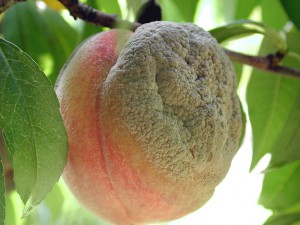
Figure 1. Brown rot on mature fruit. Entire surface of lesion is covered with spores.
Brown Rot: Warm and wet weather this summer have been ideal conditions for brown rot to develop on fruit (Figure 1). Most growers should be relying on a captan based program for mid-season covers, followed by better materials during the last 3 weeks pre-harvest. For reference see Dr. Norm Lalancette’s post Improving Your Late Season Peach Brown Rot Control Program — Plant & Pest Advisory.
Tarnished Plant Bugs; and Other Cat-facing Insects: Cat-facing insect activity is increasing with the arrival of hot weather and is present at moderate to high levels in some orchards.
Oriental Fruit Moth: A biofix point for OFM was set on 4/2 for southern counties and 4/17 in northern counties. See below for timings for third generation.
| OFM 3nd Generation Timing | ||||
| Insecticide Type | ||||
| County/Region | Degree Days by 7/7 base 45 | Conventional
2100-2200 2450-2500 |
Intrepid/Rimon
2000-2100 2350-2450 |
Diamides/Virus
2025-2150 2375-2450 |
| Gloucester – Southern | 1971 | 1st –7/11-7/14
2nd – 7/22-7/24 |
1st –7/8-7/11
2nd – 7/19-7/22 |
1st –7/9-7/12
2nd – 7/20-7/22 |
| Middlesex – Northern | 1790 | 1st – 7/17-7/20
2nd – too far off |
1st – 7/14-7/17
2nd – too far off |
1st – 7/15-7/18
2nd – too far off |
Scale Insects: Second generation White Peach Scale crawlers should emerge sometime this week or next. Second generation San Jose Scale crawlers emerge about 7/17 +/- 8 days. Esteem is a good scale material that has a 14-day PHI for stone fruit. Centaur is also effective, has a 14-day PHI and can be used only once during the growing season. Venerate has shown efficacy as a pre-harvest treatment against scale and has a 0-day PHI. If using Venerate to control scale insects, make 2 applications 7 days apart starting a week after crawler emergence.
Japanese Beetles: Japanese beetle activity has been noticeable in many orchards. Products containing imidacloprid are standard insecticides for Japanese beetle control and have a short PHI. See the NJ Commercial Tree Fruit Production Guide for more information.
Apples and Pears:
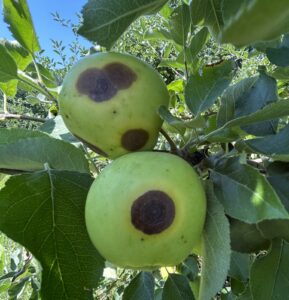
Figure 2. Bitter rot infection on apple.
Diseases: Now that primary scab has ended, the focus turns toward summer diseases such as fruit rots (esp. Bitter rot; Figure 2), and sooty blotch and fly speck. Bitter rot control has been difficult at best in recent years even where management programs have been rigorous. Research has suggested products such as Merivon, Luna Sensation, Inspire Super, Omega, and Aprovia may be effective, and longtime reliable broad-spectrum fungicides such as captan and ziram should provide control. Experience has suggested that the addition of phosphorous acid products such as Prophyt or Rampart to captan sprays may improve control. Observations are that these products improve control of other summer diseases such as sooty blotch and flyspeck, and may help suppress scab infections where present. Bitter rot symptoms have been observed in both southern and northern counties.
Brown Marmorated Stink Bugs: Brown Marmorated Stink bugs are present at low to moderate levels in orchards statewide. Eggs are hatching and nymphs are present. See the NJ Tree Fruit Production guide for effective materials.
Codling Moth (CM): Second generation timings are updated below. Trap counts and emergence are low. Therefore, if you have applied your 2nd generation insecticides and your trap counts are low (less than 5 moths per trap), additional treatments are not needed.
| Codling Moth Degree Day Timing – Second Generation | ||||||||
| Application and Insecticide Type | ||||||||
| County Area | Biofix | Rimon:
75-100DD + 14-17 days later
|
Intrepid
1150 + 1450 DD Diamides – Altacor, Voliam mixes: (150-200 DD) |
Madex
1250 DD + every 7-9 days during brood hatch (later if first spray is an IGR) |
Standard Insecticides – Delegate, Avaunt, OP’s, carbamates, pyrethroids
1250 DD + 1550 DD
|
|||
| DD | 1150 | 1450 | 1250 | 1250 | 1550 | |||
| Southern | April 28 | N/A | N/A | past | 7/10 | past | past | 7/13 |
| Northern | April 30 | N/A | N/A | past | 7/13 | 7/7 | 7/7 | 7/17 |
Scale Insects: Second generation San Jose Scale should emerge about mid-July. Options include Esteem (2 applications/year; 45-day PHI); Centaur (1 application/year; 14-day PHI); Diazinon 50W (2 applications/year; 21-day PHI); Venerate (0-day PHI; Make two applications 7 days apart starting a week after crawler emergence).
Phenology Table: Based on annual observations made in Gloucester County.
| Pest Event or Growth Stage | Approximate Date | 2025 Observed Date |
| Bud Swell (Redhaven/PF-17) | March 23 +/- 15 Days | March 30 |
| 1/4″ Green Tip Red Delicious | March 31 +/- 13 Days | March 30 |
| Pink Peach (Redhaven/PF-17) | April 4 +/- 15 Days | April 1 |
| Tight Cluster Red Delicious | April 9 +/- 13 Days | April 5 |
| Full Bloom Peach (Redhaven/PF-17) | April 9 +/- 14 Days | April 10 |
| Pink Apple (Red Delicious) | April 14 +/- 12 Days | April 16 |
| Full Bloom Apple (Red Delicious) | April 22 +/- 11 Days | April 25 |
| Petal Fall (Redhaven) | April 22 +/- 10 Days | April 19 |
| Petal Fall (Red Delicious) | April 27 +/- 13 Days | May 2 |
| Shuck Split (Redhaven) | April 30 +/- 11 Days | April 26 |
| Pit Hardening | June 15 +/- 9 Days | June 15 |
Tree Fruit Trap Captures – Southern Counties
| Week Ending | STLM | TABM-A | CM | BMSB | OFM-A | DWB | OFM-P | TABM-P | LPTB | PTB |
| 4/5/2025 | 0 | 0 | 0 | 0 | 0 | 0 | 0 | 0 | 0 | 0 |
| 4/12/2025 | 0 | 0 | 0 | 0 | 6 | 0 | 0 | 0 | 0 | 0 |
| 4/21/2025 | 0 | 0 | 0 | 0 | 36 | 0 | 1 | 0 | 0 | 0 |
| 4/27/2025 | 25 | 0 | 0 | 0 | 24 | 0 | 5 | 0 | 1 | 0 |
| 5/2/2025 | 517 | 0 | 4 | 0 | 12 | 0 | 6 | 0 | 13 | 0 |
| 5/9/2025 | 159 | 4 | 10 | 0 | 3 | 16 | 5 | 4 | 46 | 0 |
| 5/16/2025 | 91 | 11 | 6 | 0 | 1 | 36 | 2 | 14 | 69 | 0 |
| 5/23/2025 | 299 | 21 | 3 | 0 | 1 | 23 | 1 | 26 | 23 | 0 |
| 5/30/2025 | 399 | 14 | 2 | 0 | 0 | 41 | 1 | 11 | 10 | 3 |
| 6/6/2025 | 733 | 13 | 1 | 0 | 0 | 36 | 2 | 12 | 29 | 1 |
| 6/13/2025 | 684 | 19 | 2 | 1 | 0 | 81 | 2 | 17 | 22 | 8 |
| 6/20/2025 | 724 | 24 | 2 | 0.5 | 1 | 60 | 1 | 23 | 19 | 12 |
| 6/27/2025 | 932 | 5 | 1 | 0.8 | 1 | 40 | 0 | 5 | 24 | 14 |
| 7/4/2025 | 643 | 0 | 0 | 0.75 | 1 | 17 | 0 | 0 | 6 | 16 |
Tree Fruit Trap Captures – Northern Counties
| Week Ending | STLM | TABM-A | CM | BMSB | OFM-A | DWB | OFM-P | TABM-P | LPTB | PTB | AMBROSIA BEETLE |
| 4/5/2025 | 387 | 0 | 0 | 0 | 0 | 0 | 0 | 0 | 0 | 0 | 0 |
| 4/21/2025 | 435 | 0 | 0 | 0 | 0 | 0 | 1.3 | 0 | 0 | 0 | 0 |
| 4/27/2025 | 26 | 0 | 0 | 0 | 0 | 0 | 25 | 0 | 0 | 0 | 72 |
| 5/2/2025 | 86 | 0 | 0.33 | 0 | 72.5 | 0 | 47.2 | 0 | 0 | 0 | 136 |
| 5/9/2025 | 56 | 0 | 5.3 | 0 | 58.8 | 0 | 22.9 | 0 | 0 | 0 | 145 |
| 5/16/2025 | 13.75 | 2.6 | 7.3 | 0 | 4 | 0 | 5 | 0 | 0 | 0 | 50.5 |
| 5/23/2025 | 4.8 | 10.3 | 10.5 | 0 | 0.6 | 31.25 | 4.2 | 0 | 14.6 | 1 | 22.2 |
| 5/30/2025 | 2.2 | 4.8 | 1.8 | 0 | 0 | 12.4 | 9.6 | 0 | 9.6 | 1.9 | 22.1 |
| 6/6/2025 | 3 | 4.83 | 2.8 | 0.25 | 0 | 20 | 4.1 | 0 | 21.2 | 1.8 | 40.3 |
| 6/13/2025 | 65 | 20 | 11.4 | 0.6 | 0 | 12.3 | 4 | 0 | 10.5 | 1.5 | 59.2 |
| 6/20/2025 | 26 | 26 | 8 | 0.75 | 1 | 13 | 4.5 | 0 | 11 | 0.75 | 52 |
| 6/27/2025 | 145 | 19 | 6 | 1.3 | 6 | 35 | 5.4 | 0 | 16 | 1.6 | 38 |
| 7/4/2025 | 212 | 6 | 3 | 6 | 12.5 | 40 | 2 | 0 | 8.4 | 1.1 | 27 |
Grape: The next timing for Grape Berry Moth will be on or about 7/24 for Intrepid or Diamides, or a few days later for other insecticides based on the biofix of May 24 in southern counties. Treatments for the third generation are at an accumulation of 1620 degree days (base 47.14).
Blueberry: Spotted-wing drosophila, Oriental beetle, and Sharp-nosed leafhopper have increased from the previous week. Blueberry maggot trap counts remain low. For weekly reports on blueberry pests and recommendations read the Rutgers Blueberry Bulletin.
| Week Ending | SWD AC Traps | SWD BC Traps | OB AC Traps | OB BC Traps | ||||
| AVG | HIGH | AVG | HIGH | AVG | HIGH | AVG | HIGH | |
| 6/6/25 | 8.5 | 29 | 3 | 9 | 7.8 | 29 | 0 | 0 |
| 6/13/25 | 21.51 | 45 | 32.6 | 86 | 240 | 1350 | 34 | 170 |
| 6/20/25 | 37.52 | 148 | 37.6 | 83 | 405 | 2025 | 555.4 | 4050 |
| 6/27/25 | 13.5 | 34 | 27.4 | 67 | 681 | 2025 | 134.9 | 450 |
| 7/4/25 | 21.2 | 73 | 41.1 | 64 | 541 | 2025 | 331.6 | 1575 |
| SWD = Spotted-Wing Drosophila, OB = Oriental Beetle; AC = Atlantic County, BC = Burlington County | ||||||||
| Week Ending | BBM AC Traps | BBM BC Traps | SNLH AC Traps | SNLH BC Traps | ||||
| AVG | HIGH | AVG | HIGH | AVG | HIGH | AVG | HIGH | |
| 6/6/25 | 0 | 0 | 0 | 0 | 1 | 6 | 0.85 | 3 |
| 6/13/25 | 0.29 | 7 | 0.16 | 4 | 1.26 | 8 | 3.27 | 17 |
| 6/20/25 | 0 | 0 | 0.04 | 1 | 1.28 | 8 | 4 | 16 |
| 6/27/25 | 0.05 | 4 | 0 | 0 | 0.25 | 1 | 0.28 | 2 |
| 7/4/25 | 0 | 0 | 0 | 0 | 0.81 | 13 | 1.17 | 4 |
| BBM = Blueberry Maggot, SNLH = Sharp-nosed Leafhopper; AC = Atlantic County, BC = Burlington County | ||||||||
When Plants Get Sick, Pests Thrive: The Unseen Battle in Cranberry Bogs
Our research on how cranberries respond to phytoplasma infection—and its effects on above- and belowground herbivores—was recently featured on the Theobald Smith Society’s website in the article When Plants Get Sick, Pests Thrive: The Unseen Battle in Cranberry Bogs
Phytoplasma infection, which causes false blossom disease in cranberries, is transmitted by the blunt-nosed leafhopper (Limotettix vaccinii). Our findings show that infection increases cranberry susceptibility to herbivores both above and below ground by increasing plant nutrient levels and suppressing plant defenses. This work highlights the complex—and often harmful—interactions among plants, pathogens, and insect herbivores in agricultural ecosystems.
Fruit IPM Report June 30, 2025
Peach:
Diseases: Bacterial Spot: This disease is still present, and has increased in severity in some orchards. Brown Rot: With the recent rains, sulfur should not be part of the spray program. Most growers should be relying on a captan based program for mid-season covers, followed by better materials during the last 3 weeks pre-harvest. See the NJ Commercial Tree Fruit Production Guide for more information.
Oriental Fruit Moth: A biofix point for OFM was set on 4/2 for southern counties and 4/17 in northern counties. We are past treatment timings targeting the second generation.
Japanese Beetles: Japanese beetles have been observed feeding on fruit across the state. Products containing imidacloprid (Admire Pro, Leverage 360) are effective and have a short preharvest interval.
Tarnished Plant Bugs; and Other Catfacing Insects: Catfacing insects remain very active. Very little recent fruit feeding has been observed.
Thrips: Flower Thrips have been observed feeding in highly colored ripening fruit, especially in poorly managed ground covers that contain clover or other flowering weeds. Thrips damage appears as “silvering” and usually appears on fruit close to harvest. If populations are high damage can be extensive. Presence of thrips may be scouted for using a beating tray to detect the presence of adults and nymphs in the tree. Flowering weeds and shrubs on orchard edges may also be scouted by shaking flowers onto a beating tray or a sheet of paper. Delegate or Entrust at the highest labeled rate are the usual recommended materials for thrips in stone fruit. Lannate may be effective in some orchards but has not worked well in recent years. These materials all have short PHI’s and may be applied close to harvest when damage typically appears. Damage is different than peach and appears as a dark streak in a similar pattern as silvering. See the NJ Commercial Tree Fruit Production Guide for more information.
Apples and Pears:
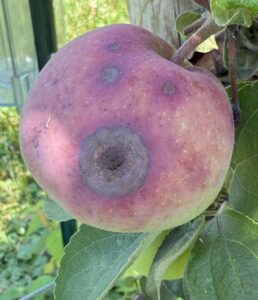
Figure 1. Bitter rot lesions on apple. Photo by Kaitlin Quinn.
Diseases: Now that primary scab has ended, the focus turns toward summer diseases such as fruit rots (esp. Bitter rot), and sooty blotch and fly speck. Bitter rot control has been difficult at best in recent years even where management programs have been rigorous. Research has suggested products such as Merivon, Luna Sensation, Inspire Super, Omega, and Aprovia may be effective, and longtime reliable broad spectrum fungicides such as captan and ziram should provide control. Experience has suggested that the addition of phosphorous acid products such as Prophyt or Rampart to captan sprays may improve control. Observations are that these products improve control of other summer diseases such as sooty blotch and flyspeck, and may help suppress scab infections where present. Bitter rot symptoms were observed last week in southern and northern counties (Figure 1).
Codling Moth (CM): A codling moth biofix was set in southern counties on 4/28 and in northern counties on 4/30. The first generation codling moth timings have ended. Second generation timings are updated below. Rimon is not recommended for this and later generations.
| Codling Moth Degree Day Timing – Second Generation | ||||||||
| Application and Insecticide Type | ||||||||
| County Area | Biofix | Rimon:
75-100DD + 14-17 days later
|
Intrepid
1150 + 1450 DD Diamides – Altacor, Voliam mixes: (150-200 DD) |
Madex
1250 DD + every 7-9 days during brood hatch (later if first spray is an IGR) |
Standard Insecticides – Delegate, Avaunt, OP’s, carbamates, pyrethroids
1250 DD + 1550 DD
|
|||
| DD | 1150 | 1450 | 1250 | 1250 | 1550 | |||
| Southern | April 28 | N/A | N/A | 6/29 | 7/9 | 7/2 | 7/2 | 7/13 |
| Northern | April 30 | N/A | N/A | 7/3 | 7/18 | 7/8 | 7/8 | 7/23 |
Phenology Table: Based on annual observations made in Gloucester County.
| Pest Event or Growth Stage | Approximate Date | 2025 Observed Date |
| Bud Swell (Redhaven/PF-17) | March 23 +/- 15 Days | March 30 |
| 1/4″ Green Tip Red Delicious | March 31 +/- 13 Days | March 30 |
| Pink Peach (Redhaven/PF-17) | April 4 +/- 15 Days | April 1 |
| Tight Cluster Red Delicious | April 9 +/- 13 Days | April 5 |
| Full Bloom Peach (Redhaven/PF-17) | April 9 +/- 14 Days | April 10 |
| Pink Apple (Red Delicious) | April 14 +/- 12 Days | April 16 |
| Full Bloom Apple (Red Delicious) | April 22 +/- 11 Days | April 25 |
| Petal Fall (Redhaven) | April 22 +/- 10 Days | April 19 |
| Petal Fall (Red Delicious) | April 27 +/- 13 Days | May 2 |
| Shuck Split (Redhaven) | April 30 +/- 11 Days | April 26 |
| Pit Hardening | June 15 +/- 9 Days | June 15 |
Tree Fruit Trap Captures – Southern Counties
| Week Ending | STLM | TABM-A | CM | BMSB | OFM-A | DWB | OFM-P | TABM-P | LPTB | PTB |
| 4/5/2025 | 0 | 0 | 0 | 0 | 0 | 0 | 0 | 0 | 0 | 0 |
| 4/12/2025 | 0 | 0 | 0 | 0 | 6 | 0 | 0 | 0 | 0 | 0 |
| 4/21/2025 | 0 | 0 | 0 | 0 | 36 | 0 | 1 | 0 | 0 | 0 |
| 4/27/2025 | 25 | 0 | 0 | 0 | 24 | 0 | 5 | 0 | 1 | 0 |
| 5/2/2025 | 517 | 0 | 4 | 0 | 12 | 0 | 6 | 0 | 13 | 0 |
| 5/9/2025 | 159 | 4 | 10 | 0 | 3 | 16 | 5 | 4 | 46 | 0 |
| 5/16/2025 | 91 | 11 | 6 | 0 | 1 | 36 | 2 | 14 | 69 | 0 |
| 5/23/2025 | 299 | 21 | 3 | 0 | 1 | 23 | 1 | 26 | 23 | 0 |
| 5/30/2025 | 399 | 14 | 2 | 0 | 0 | 41 | 1 | 11 | 10 | 3 |
| 6/6/2025 | 733 | 13 | 1 | 0 | 0 | 36 | 2 | 12 | 29 | 1 |
| 6/13/2025 | 684 | 19 | 2 | 1 | 0 | 81 | 2 | 17 | 22 | 8 |
| 6/20/2025 | 724 | 24 | 2 | 0.5 | 1 | 60 | 1 | 23 | 19 | 12 |
| 6/27/2025 | 932 | 5 | 1 | 0.8 | 1 | 40 | 0 | 5 | 24 | 14 |
Tree Fruit Trap Captures – Northern Counties
| Week Ending | STLM | TABM-A | CM | BMSB | OFM-A | DWB | OFM-P | TABM-P | LPTB | PTB | AMBROSIA BEETLE |
| 4/5/2025 | 387 | 0 | 0 | 0 | 0 | 0 | 0 | 0 | 0 | 0 | 0 |
| 4/21/2025 | 435 | 0 | 0 | 0 | 0 | 0 | 1.3 | 0 | 0 | 0 | 0 |
| 4/27/2025 | 26 | 0 | 0 | 0 | 0 | 0 | 25 | 0 | 0 | 0 | 72 |
| 5/2/2025 | 86 | 0 | 0.33 | 0 | 72.5 | 0 | 47.2 | 0 | 0 | 0 | 136 |
| 5/9/2025 | 56 | 0 | 5.3 | 0 | 58.8 | 0 | 22.9 | 0 | 0 | 0 | 145 |
| 5/16/2025 | 13.75 | 2.6 | 7.3 | 0 | 4 | 0 | 5 | 0 | 0 | 0 | 50.5 |
| 5/23/2025 | 4.8 | 10.3 | 10.5 | 0 | 0.6 | 31.25 | 4.2 | 0 | 14.6 | 1 | 22.2 |
| 5/30/2025 | 2.2 | 4.8 | 1.8 | 0 | 0 | 12.4 | 9.6 | 0 | 9.6 | 1.9 | 22.1 |
| 6/6/2025 | 3 | 4.83 | 2.8 | 0.25 | 0 | 20 | 4.1 | 0 | 21.2 | 1.8 | 40.3 |
| 6/13/2025 | 65 | 20 | 11.4 | 0.6 | 0 | 12.3 | 4 | 0 | 10.5 | 1.5 | 59.2 |
| 6/20/2025 | 26 | 26 | 8 | 0.75 | 1 | 13 | 4.5 | 0 | 11 | 0.75 | 52 |
| 6/27/2025 | 145 | 19 | 6 | 1.3 | 6 | 35 | 5.4 | 0 | 16 | 1.6 | 38 |
Grape: The biofix in southern counties for Grape berry moth (GBM) was 5/24. Model timing will predict IGR and diamide materials for the second generation. The model works best when growers record their own bloom dates and use the Grape Berry Moth model at NEWA. The timing is set at 810 degree days base 470F for the second generation treatments using Diamides or Intrepid, which was approximately June 27 for southern counties. Other materials may be applied 2-3 days later. As we enter the summer period of disease management the focus shifts to cultural controls including leaf pulling, along with well-timed fungicide applications for downy mildew and powdery mildew management.
Blueberry: Spotted-wing drosophila (SWD) and Oriental beetle (OB) captures decreased from previous weeks likely due to heat. Blueberry maggot and sharp-nosed leafhopper trap counts remain low. For weekly reports on blueberry pests and recommendations read the Rutgers Blueberry Bulletin. For information on insecticides labelled for SWD control in small fruit crops, see the attached Table 1.
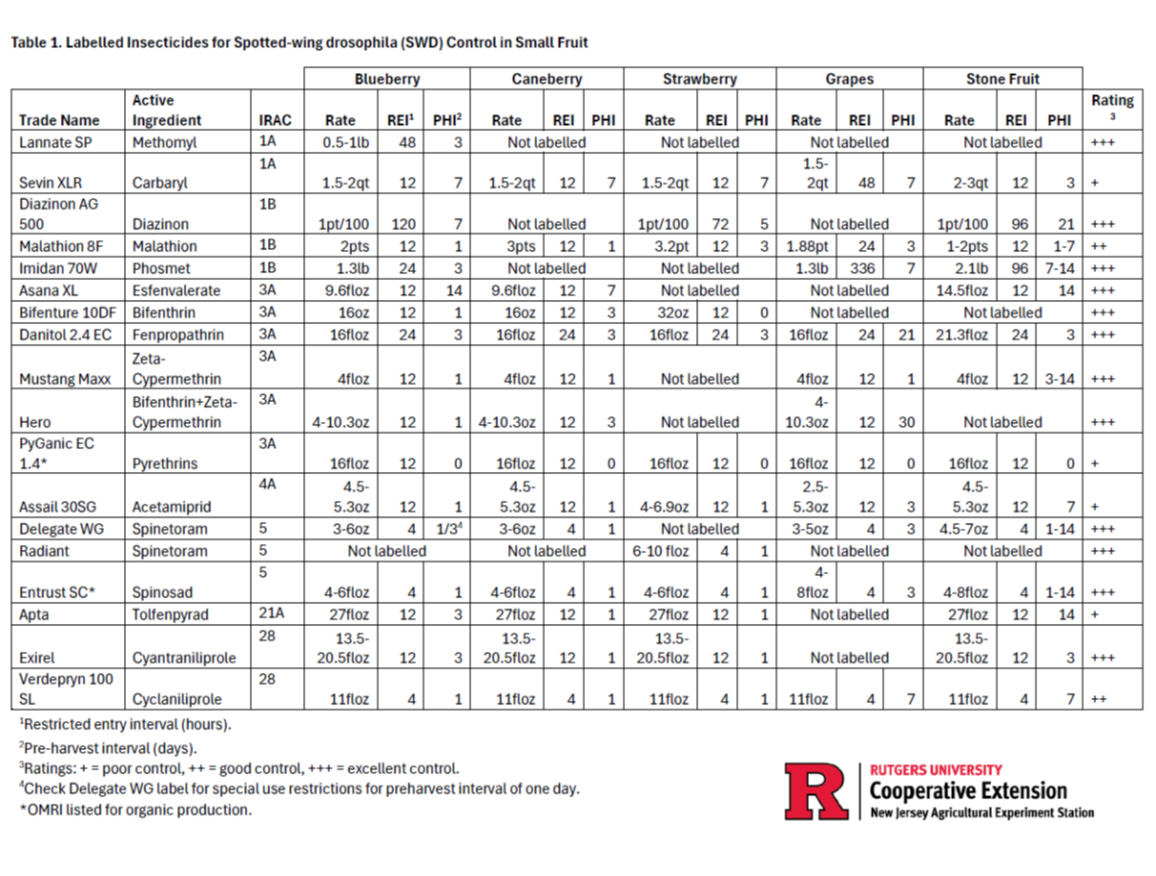
Late June Peach Varieties for New Jersey– New and Standard
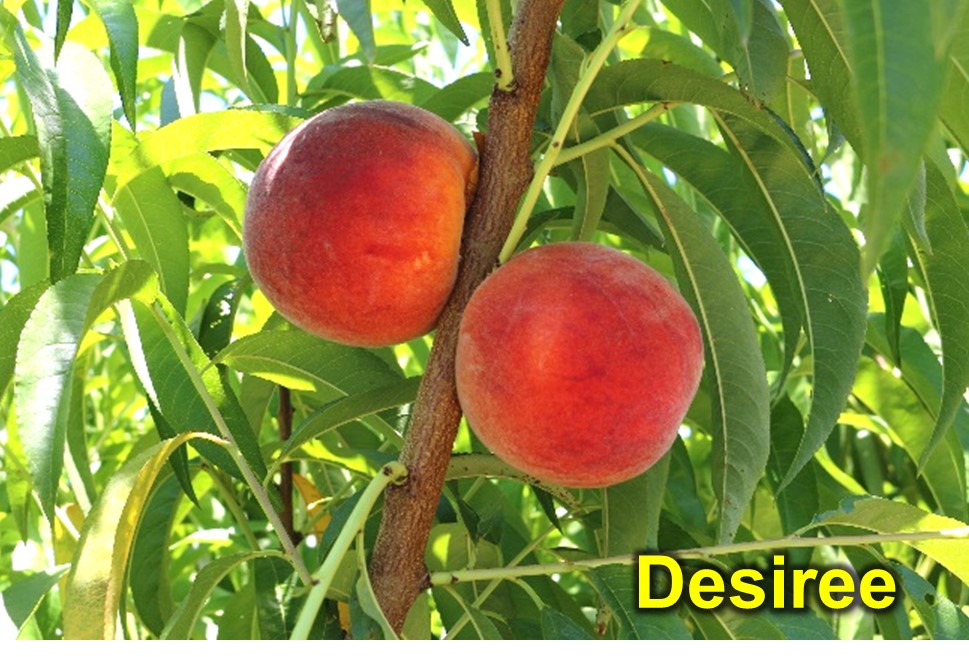 The many peach varieties grown in New Jersey were developed in different breeding programs from several peach-growing regions, including the Rutgers Tree Fruit Breeding program. Recent evaluations have examined the known characteristics and challenges growers face in growing these varieties. These are important for making planting, thinning, harvesting, post-harvest handling, and marketing-related decisions. Understanding these differences is important for selecting varieties or replacing existing ones.
The many peach varieties grown in New Jersey were developed in different breeding programs from several peach-growing regions, including the Rutgers Tree Fruit Breeding program. Recent evaluations have examined the known characteristics and challenges growers face in growing these varieties. These are important for making planting, thinning, harvesting, post-harvest handling, and marketing-related decisions. Understanding these differences is important for selecting varieties or replacing existing ones.
Desiree is a very attractive yellow-fleshed, clingstone peach variety, ripening during the last week of June. The fruit is beautiful and medium to moderately large, which is impressive for the early-season variety. The flesh is firm with a very sweet and tangy flavor. The tree is vigorous, and its leaves have low susceptibility to bacterial spot. The fruit is also having low susceptibility to Bacterial Spot. [Read more…]
2025 Summer Orchard Tour and Educational Program
2025 Summer Orchard Tour and Educational Program
Sponsored by:
The New Jersey State Horticultural Society
in cooperation with
Rutgers Cooperative Extension of Hunterdon County
Wednesday July 9, 2025 4:00 – 8:00 PM
Hosted by: Kurt Alstede at Alstede Farms
Harvest Hall
100 Route 24
Chester, NJ O7930
Cost: $20.00 includes dinner
Program
4:00 PM: Registration
4:30 PM: Farm Tour /Wagon Ride
Win Cowgill, Kurt Alstede, Colin Manning and Rebekah Alstede-Modery
5:45 PM: Dinner
6:15 PM: Welcome Remarks – Win Cowgill
6:45 PM: Rutgers IPM Mating Disruption Research
Janine Spies PhD, State Fruit IPM Program Leader, Rutgers NJAES
7:30 PM: Precision Protection: Harnessing Pheromone Tech in the Battle Against Invasive Orchard Pests
Haydn Lenz, PNW Technical Field Specialist Suterra
The following NJDEP Pesticide will be awarded.
1 Unit Category 1A 1 Unit PP2
Preregistration required by Monday July 7 at https://njshs.org/event-6223337
Email: njhortsociety@gmail.com
